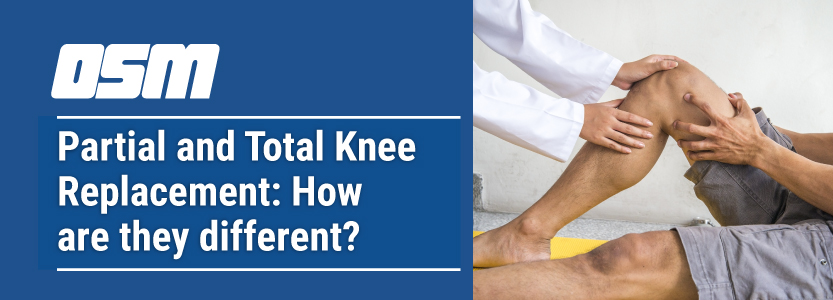Partial and Total Knee Replacement: How are they different?
From Noyes Knee Institute
Strong, healthy knees are important for your mobility. Unfortunately, the knee joint is easily injured and is susceptible to damage from arthritis. Any damage or injury to the knee is painful and may limit your daily activities. Depending on which part of your knee is damaged, you may have the option of either a total or partial knee replacement.
Learn more about the difference between partial and total knee replacement to decide which is right for you.
Parts of the Knee
The knee joint consists of four bones: the femur, tibia, fibula, and patella. Four ligaments — two collateral and two cruciate — stabilize the connection of the bones while allowing movement. Menisci, or cartilage, minimizes the trauma of the femur and tibia sliding across each other, and small sacs of fluid between bones allow for smooth movement.
The knee is also divided into three distinct compartments: The medial compartment is the section of knee on the inside of the leg, the lateral compartment is on the outside of the leg, and the patellofemoral compartment is the area directly under the kneecap. A partial knee replacement is done when only one of these compartments is damaged.
Total Knee Replacement
A total knee replacement involves resurfacing the ends of the tibia and femur to remove all the damaged tissue. The damage could be deteriorated bone, cracked bone, or calcified bone as well as the damaged cartilage. Once the bad tissue is removed, metal caps are placed over the bones to recreate their original shape and size. These caps may snap on snugly or be glued in place.
With the bones recreated, the doctor determines whether the kneecap has been damaged or not. If there is damage, the underside will be cleaned, and then a plastic disc will be fit into place. Finally, plastic pacers are placed between all parts that may rub or slide against each other during movement.
Either or both of the cruciate ligaments of the knee may be removed during a total knee replacement if they are damaged. The collateral ligaments are not removed. When a cruciate ligament is taken out, the metal caps over the bones have a ridge or locking mechanism to ensure your bones do not move too far or slip out of place.
Partial Knee Replacement
A partial knee replacement requires the same resurfacing and metal caps but involves either the medial or lateral compartment. If both compartments have damaged tissue, or if the problem is within the patellofemoral compartment, a different treatment is needed.
If your knee is unstable and the bones slip to the side, forward, or backward, partial knee replacement is not an option. In addition, the anterior cruciate ligament must not be damaged for this procedure to work. No ligament is removed during a partial knee replacement.
When only one compartment needs repaired, you may consider a partial knee replacement. If your doctor deems you a good candidate for this procedure you will experience a few benefits over a total knee replacement. One of the most important benefit is that your knee will still function the way it always has because less of the joint is removed and replaced.
With a partial replacement, you may require more surgery and a total replacement in the future. One reason for this is that a partial replacement does not last as long as a total replacement. The other reason is that the remaining natural parts of the joint may become damaged as you age and require replacement too.
The Orthopedic & Sports Medicine Center of Oregon is an award-winning, board-certified orthopedic group located in downtown Portland Oregon. We utilize both surgical and nonsurgical means to treat musculoskeletal trauma, spine diseases, sports injuries, degenerative diseases, infections, tumors and congenital disorders.
Our mission is to return our patients back to pain-free mobility and full strength as quickly and painlessly as possible using both surgical and non-surgical orthopedic procedures.
Our expert physicians provide leading-edge, comprehensive care in the diagnosis and treatment of orthopedic conditions, including total joint replacement and sports medicine. We apply the latest state-of-the-art techniques in order to return our patients to their active lifestyle.
If you’re looking for compassionate, expert orthopedic surgeons in Portland Oregon, contact OSM today.
Phone:
503-224-8399
Address
17355 Lower Boones Ferry Rd Suite 100A
Lake Oswego, OR 97035
Hours
Monday–Friday
8:00am – 4:30pm



